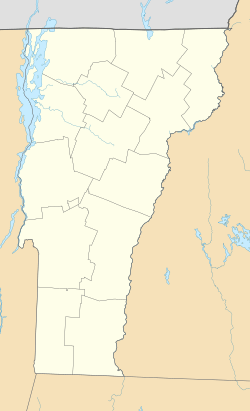Mad River Valley Rural Historic District facts for kids
Quick facts for kids |
|
|
Mad River Valley Rural Historic District
|
|

Farmhouse on VT 100
|
|
| Location | Roughly, along VT 100 and 100B, and parts of North and River Rds., Waitsfield and Moretown, Vermont |
|---|---|
| Area | 1,400 acres (570 ha) |
| Architectural style | Greek Revival, Gothic Revival |
| MPS | Mad River Valley MPS |
| NRHP reference No. | 94000836 |
| Added to NRHP | August 5, 1994 |
The Mad River Valley Rural Historic District is a special area in Vermont. It covers a large countryside space in northern Waitsfield and southern Moretown, Vermont. This district is about 1,400 acres big. It sits on both sides of the Mad River. People have farmed here since the late 1700s. You can still see many old farmhouses from the mid-1800s. This historic district was added to the National Register of Historic Places in 1994.
Exploring the Mad River Valley
The Mad River in Vermont flows north. It joins the Winooski River, which then flows into Lake Champlain. The historic district follows the Mad River. It is generally bordered by North Road to the east. Vermont Route 100 is to the west. Tremblay Road marks the southern edge. To the north, the boundary is near Downsville Brook. This brook flows east in Moretown.
The River's Path
This part of the Mad River valley is wider. The river's path gets narrower at the north and south ends. Meadow Road cuts through the middle of the district. This road crosses the river at one of the oldest crossing spots in the area.
A Look Back in Time
White settlers first came to this part of the Mad River valley in the 1780s. They were drawn by the good land for farming. The first road was built by 1796. It was roughly from North Road to the Meadow Road crossing. The Mad River Turnpike opened in 1807. This is now Vermont Route 100 and Route 100B.
Early farmers grew many different crops and raised various animals. By the mid-1800s, they focused on cattle and Morgan horses. Later in the 1800s, trains came to a nearby valley. Refrigerated rail cars were also invented. This allowed farmers to start making butter. Many farmhouses you see today got their current look during this time. Some active farms have added modern buildings. You can find great examples of these farmsteads on Vermont 100 and North Road. They were usually built away from the river. This is because the Mad River has often flooded over the years.



